Key Takeaways About Nitecore Batteries
- Li-ion batteries have a range of different capacities.
- Battery voltage lets you know how strong the electric current is when discharged.
- The output current lets you know the battery’s discharge rate.
- There are many different Nitecore batteries, each for specific needs.
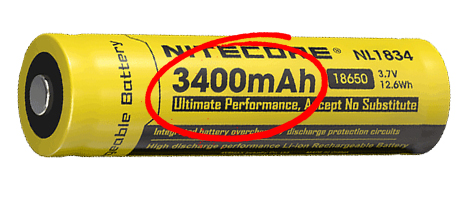
Battery Capacity
Just like li-ion batteries can come in a variety of physical sizes, there is also a range of battery capacities available. A battery capacity, labeled in milliamp hours or mAh, clues us in to how much charge the battery can hold. What this means for you is the larger the capacity of the battery, the longer runtime you’ll get on a single charge.
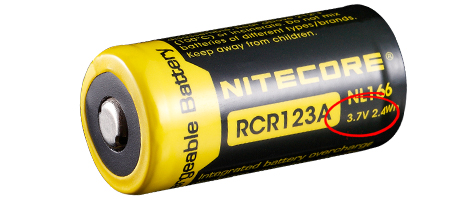
Battery Voltage
Voltage lets you know the electric potential of the battery, or in simpler terms, how strong the electric current is when discharged from the battery. Most li-ion batteries have a low voltage between 3 and 3.7V.
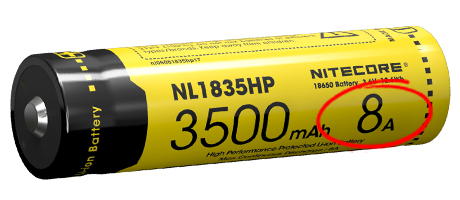
Battery Output Current
While voltage tells us the strength of the battery output, we also need to know how much electrical current is flowing at a given time. For this we can look at a battery’s discharge rate which is measured in amps or A.
A standard, button-top 18650 battery will usually have a discharge rate around 5A (or often not list the discharge rate at all!). As advances in LED technology have demanded higher and higher outputs, nowadays you’ll see some flashlights like the EC23, MH23 and HC33 require a high discharge rate to enable the brightest modes. If this is the case for your flashlight, you’ll want to seek out batteries that meet the minimum discharge rate specified by the manufacturer.
Flat-top vs. Button-top
With a few exceptions, NITECORE flashlights require button-top batteries to function. Not only does this ensure a proper contact inside the flashlight, but the “button” is actually a small protective circuit that helps prevent short circuits and over discharging.
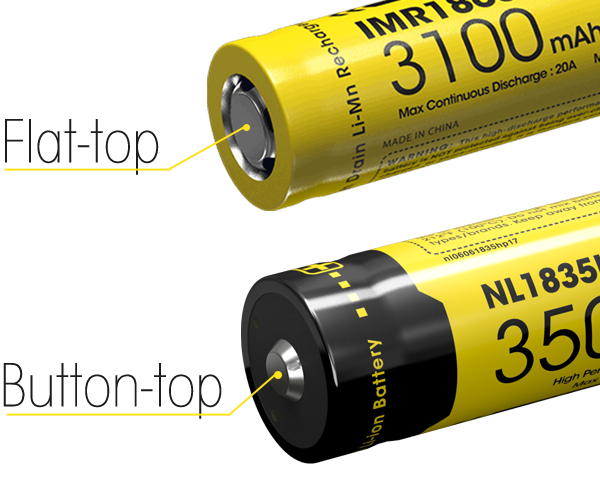
Specialty Batteries
You might see some NITECORE batteries labeled as HP or USB-rechargeable and wonder what the difference is or when you might need these batteries. Here’s a quick run down of some speciality li-ion batteries available and when they come in handy.
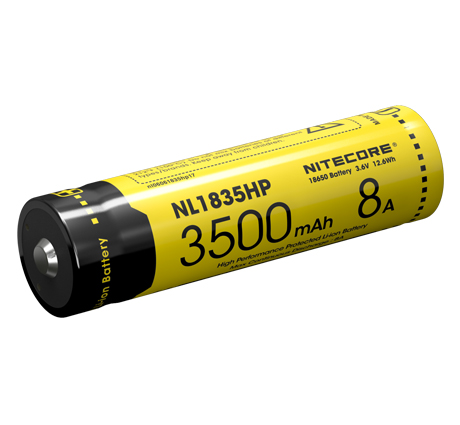
High performance
Some flashlights need batteries with a high discharge rate in order to reach the brightest outputs. You’ll find batteries with an “HP” designation after the numerical name will provide high drain outputs that are often required to get your flashlight to reach the full brightness potential.
One good reason not to shy away from High Performance batteries: they’re backwards compatible! If you have an older LED flashlight that runs on regular old 18650s, you can still use HP batteries without worrying about the higher discharge rate affecting your device. We frequently recommend these Nitecore batteries to anyone who currently owns an older model but thinks they might upgrade in the future to one of our high performance flashlights.
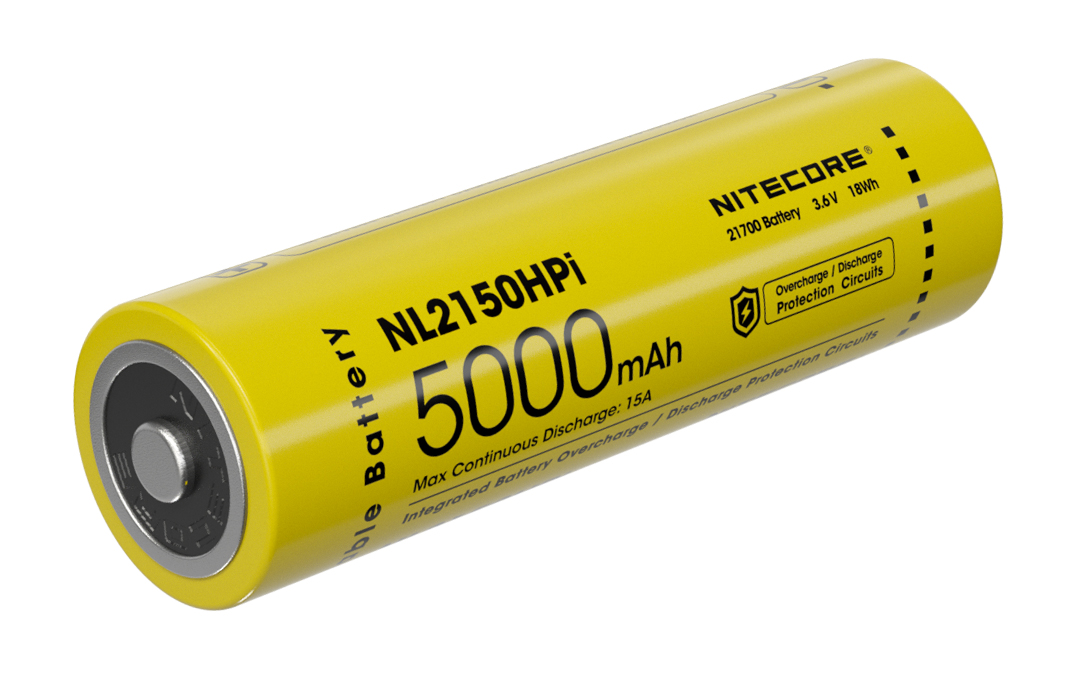
i Series battery
Latest technology advancement has led to the creation of the Nitecore i Series 21700 battery. These Nitecore batteries have an “i” designation on them. This battery has taken battery performance to the next level with its powerful output.
The 21700 i Series battery has a dual way output with positive and negative polarities at both ends and a high energy density of up to 240mWh/g. This enables it to have a highly efficient output by minimizing the loss of power due to internal resistance. The reduction of the internal resistance grants the battery to offer a direct energy conversion to power the device. This battery is ideal for high drain devices.
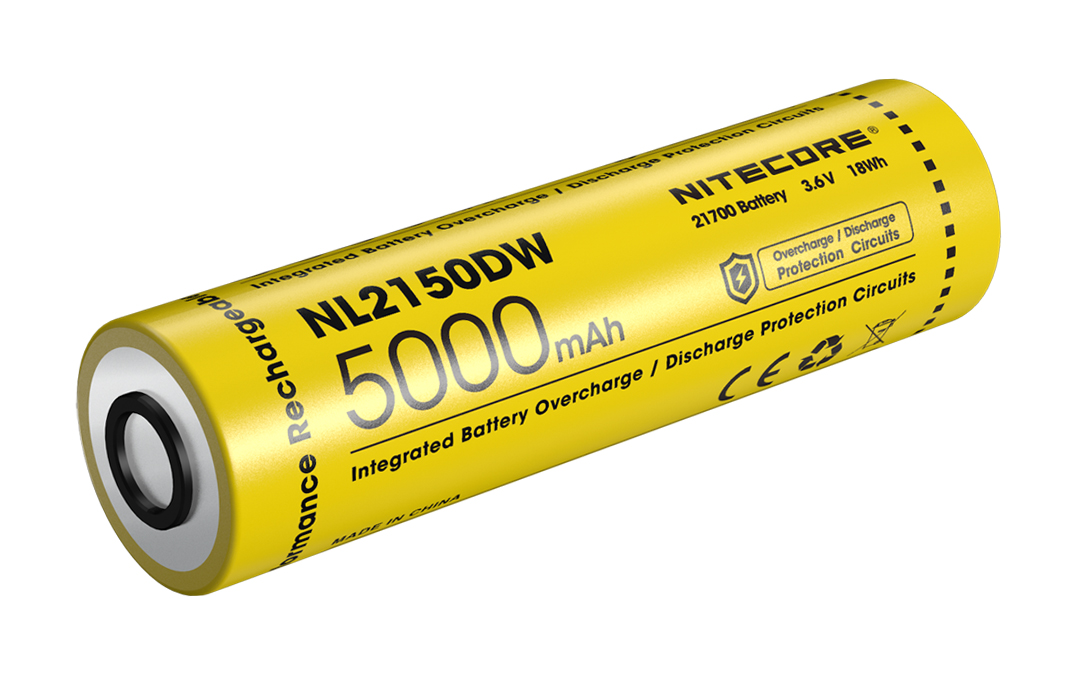
DW Series battery
The DW Series battery was designed specifically for the R40 V2 flashlight and can only work with this flashlight. Because this flashlight is mainly used as a work light it means it needs a powerful and long battery life, which is exactly what the DW series offers.
The NITECORE NL2150DW has an amazing 5000mAh capacity. This powerful battery has improved performance, and superior energy density compared to previous 18650 batteries. The DW Series battery design allows for the R40 V2 flashlight to charge wirelessly via two docks provided with the flashlight. The battery also features a built-in pressure relief valve, high temperature resistant design, and built-in safeguards to prevent surges. This protects you from overcharging, over-discharging, as well as short-circuits.
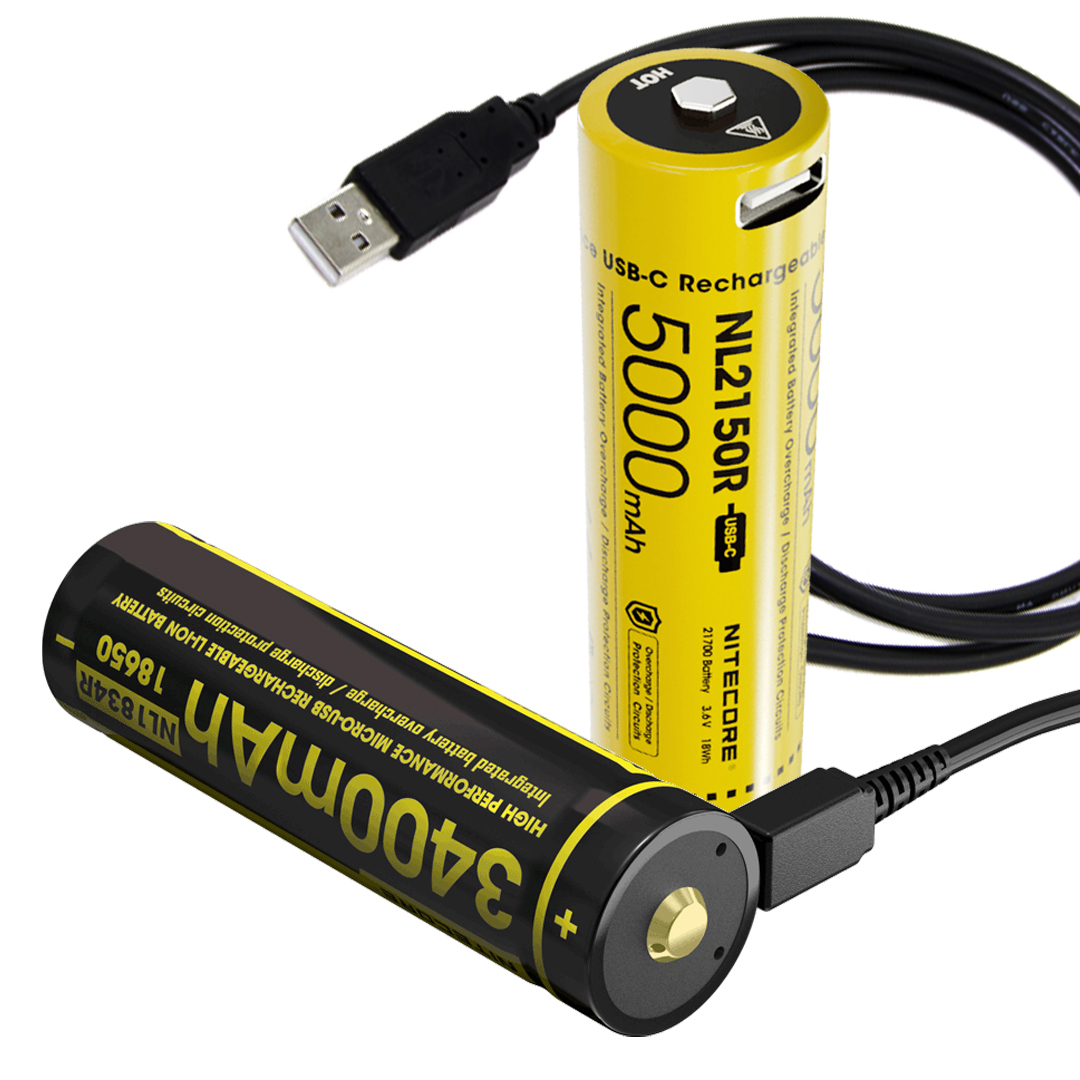
USB Rechargeable
One of the newest advances in li-ion batteries is the introduction of USB rechargeable batteries. That’s right, these cells come with a micro-USB or USB-C port built directly into the battery! These Nitecore batteries have an “R” on them.
If you’re looking to minimize your carry or want to supplement a flashlight that doesn’t have a built-in charging port, these Nitecore batteries are for you. Compatible with common USB power sources such as power banks, solar panels and laptops (and traditional chargers, too!), all you need to do is plug these batteries in to charge. An indicator light underneath the positive pole goes from red to green to indicate charging progress.
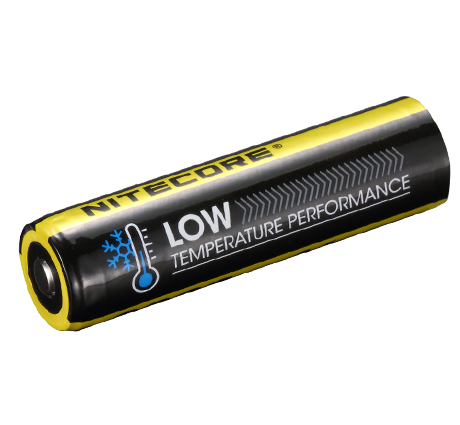
Low temperature
If you plan on using your flashlight in cold temperatures (think sub-zero), you might want to consider picking up Nitecore batteries designated for use in low temperatures. Designated as LT in their model names, these batteries are optimized for, you guessed it, low temps.
Traditionally, CR123A batteries were the preferred power source for anything cold weather due to their chemistry’s superior performance. Now, NITECORE makes the NL1829LTP low temp battery, NL1829LTHP low temp, high performance battery and NL1829RLTP USB rechargeable, low temp, high performance battery — all designed to perform in cold temperatures all the way down to -40 F.
Nitecore Power Bank Lineup – Updated!

Nitecore Power Banks at a Glance: The NB series offers lightweight, low-profile options that are perfect for everyday activities and staying power on the go. The NPB series offers slightly larger, more durable power banks that are great for all outdoor activities and everyday carry. Nitecore Power Banks Picking a great power bank can be […]
Secrets of Power Banks: How Long Does It Take to Charge?
Last modified on November, 2024 by Kristen Caldera

Key Takeaways: Charging times can be estimated by using the battery capacity and input current Factors such as output power, quick charge technology, cable quality, battery level, and environmental temperatures can also affect charging times In today’s fast-paced, technology-driven world, staying connected is essential. Whether you’re a frequent traveler, a student, or someone who relies […]
Essential Care Tips and Maintenance for Your Flashlights
Last modified on November, 2024 by Kristen Caldera

Key Takeaways: Clean your flashlight every six months to reduce buildup and debris Remove flashlight batteries when not in use to prevent corrosion Keep your flashlight safely stored in a dry cool place for optimal performance Flashlights are valuable tools that provide light and security in various situations. To ensure their reliability and longevity, proper […]
Top 5 Differences Between Lithium-ion and Lithium-polymer Batteries
Last modified on November, 2024 by Kristen Caldera

Key Takeaways: Lithium-ion batteries have a liquid makeup while lithium-polymer uses a gel-like or solid substance Li-poly batteries are used in many devices because of their flexible design Li-ion batteries can store more energy while Li-poly batteries can charge faster In our increasingly mobile and energy-dependent world, batteries have become the unsung heroes of our […]
Li-ion Batteries: How to Choose the Best One for Your Light
Last modified on November, 2024 by Chinhua

Key takeaways: A vast majority of LED flashlights produced today use li-ion batteries. Reading an Li-ion battery: The first two numbers represent the diameter of the battery in mm, the next two numbers represent the battery length in millimeters, the final digit represents the shape of the battery. Specifications to consider: Capacity, Voltage, and Current. […]
21700 Battery Guide: What You Need to Know
Last modified on November, 2024 by Chinhua

Key takeaways: 21700 battery is short-hand for a rechargeable, lithium ion battery that is 21 mm in diameter and 70 mm long. The big advantage of a 21700 battery over an 18650 battery is the overall energy capacity possible. 21700 batteries are able to reach a maximum capacity of 5000mAh. How to charge 21700 batteries […]
Traveling Light, Literally: A Guide to Bringing Flashlights and Headlamps on Airplanes
Last modified on November, 2024 by Kristen Caldera

Key Takeaways: Flashlights are permitted in both carry-on and checked bags, but specific rules must be followed. Battery flashlights are allowed depending on their make, lithium content, and Watt-Hours Although there are no specific guidelines for headlamps, it is advisable to adhere to the same rules as flashlights. When preparing for air travel, it’s essential […]
Flying with Power Banks

Key Takeaways: What type of power bank is best? Most power banks are allowed on flights What is a watt-hour? Nitecore power bank breakdown Are power banks allowed on flights? For the most part the endless loop of My Sharona is over and the ruling class has deemed it fit to loosen travel restrictions. Thus, […]
Camera Batteries for Canon, Sony, Leica, Fujifilm Cameras
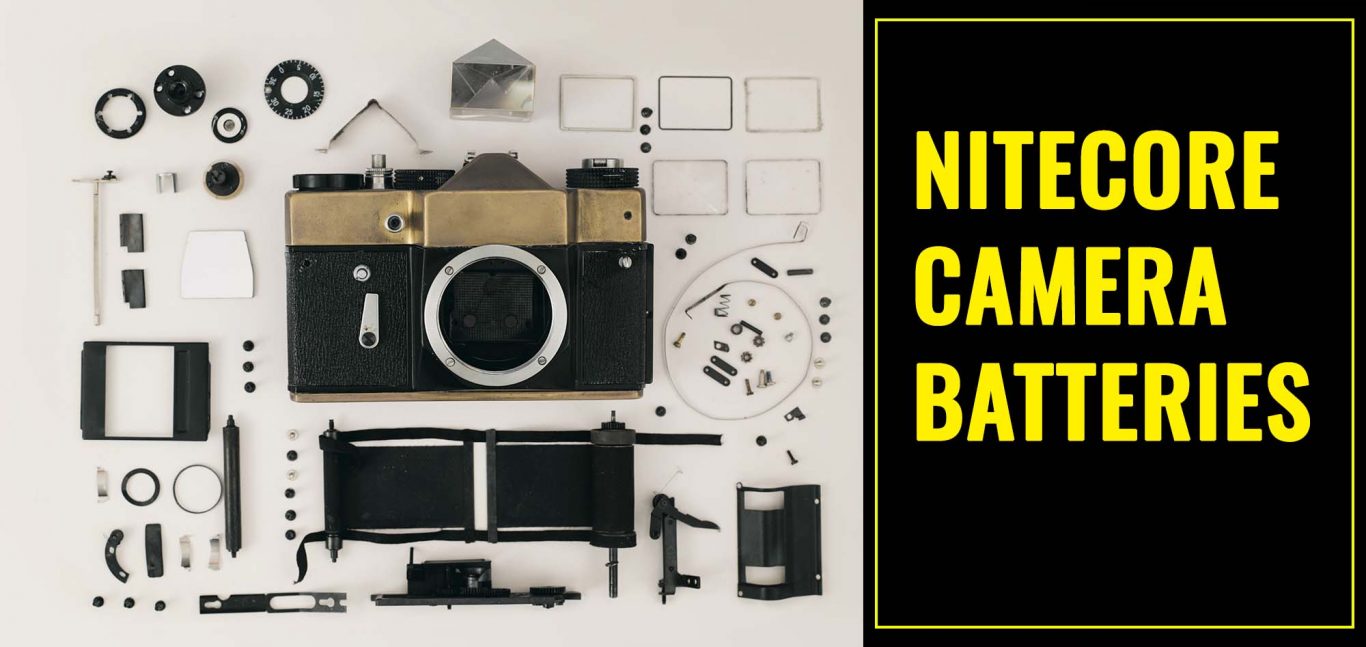
Nitecore Camera Batteries at a Glance: Compatible with major brands like Canon, Nikon, Sony, Leica, Fujifilm, Hasselblad, and GoPro Same performance, better price Nitecore manufactures replacement camera batteries for major brands like Canon, Nikon, Sony, Leica, Fujifilm, Hasselblad. and GoPro. Nitecore Products by Brand Canon Nikon Sony Leica Fujifilm Hasselblad GoPro Replacement camera batteries by […]
6 Things To Consider When Buying A Power Bank
Last modified on March, 2021 by Chinhua

Key Takeaways: You want a power bank with a capacity at least a bit higher than that of your device. A lightweight and compact power bank is ideal for carrying it everywhere. Check the charging ports, USB-C inputs are becoming popular due to their ability to charge faster. Features like fast charging or safeguard features […]

